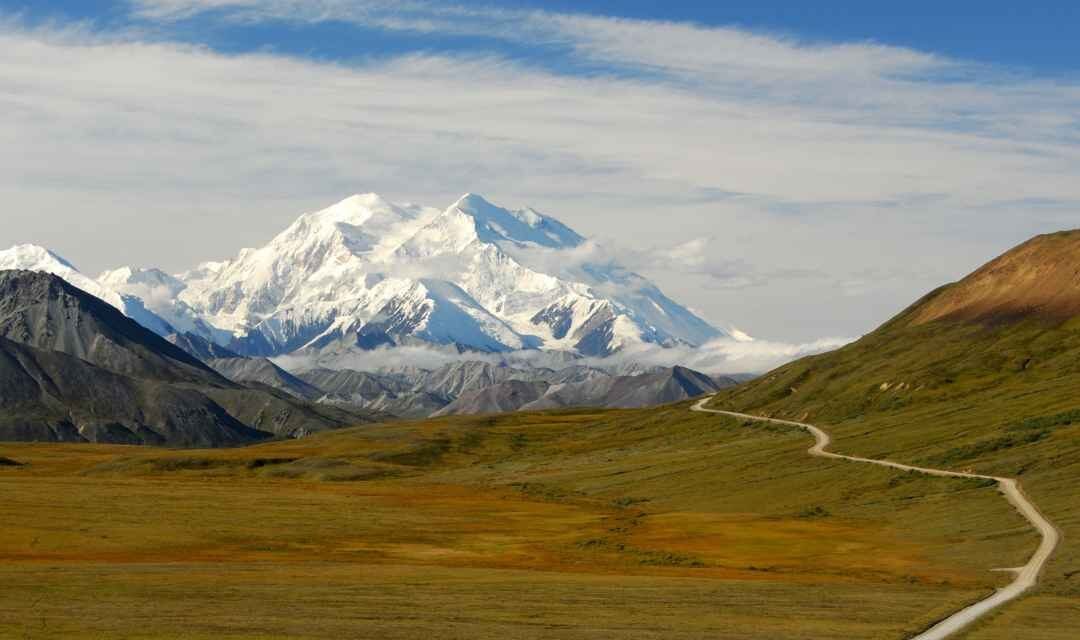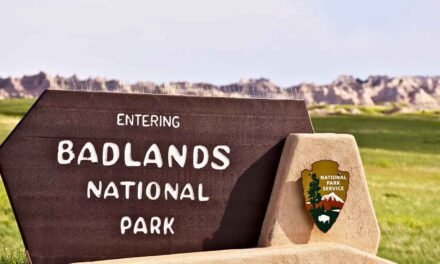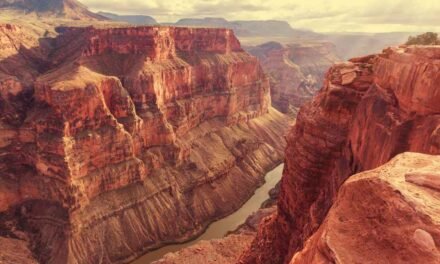Overview of Denali National Park
Denali National Park and Preserve is a breathtaking destination located in the heart of Alaska’s rugged wilderness. Established in 1917, the park encompasses over six million acres of pristine landscapes, ranging from lush forests and tundra to icy glaciers and towering mountains. Denali National Park is famous for its diverse ecosystems, abundant wildlife, and awe-inspiring scenery, with the centerpiece being Denali, the highest peak in North America, standing at 20,310 feet.
Visitors to the park are treated to a true Alaskan experience, with opportunities to spot wildlife such as grizzly bears, moose, and caribou, and enjoy a variety of outdoor activities, from hiking and mountaineering to dog sledding and snowshoeing.
Denali National Park Location
Denali National Park is located in central Alaska, approximately 240 miles north of Anchorage and 125 miles south of Fairbanks. The park’s entrance and main visitor center can be found near the small community of Denali Park, which offers a range of amenities and services for travelers.
The park is accessible by car via the Parks Highway (Alaska Route 3), with the drive taking approximately 4.5 hours from Anchorage and 2 hours from Fairbanks. Alternatively, the Alaska Railroad offers a scenic train journey from both cities to the park entrance, while several air taxi services provide flights to nearby airstrips for those looking for a more expedited journey.
Denali National Park Things to Do
Hiking and Backpacking
Denali National Park offers a range of hiking opportunities for visitors of all skill levels. There are several maintained trails near the park entrance, including the Horseshoe Lake Trail, Savage River Loop, and Triple Lakes Trail. For more experienced hikers and backpackers, the park’s vast wilderness areas provide countless opportunities for off-trail exploration and multi-day treks.
Wildlife Viewing
Denali National Park is home to a diverse array of wildlife, making it a premier destination for wildlife enthusiasts. The park’s “Big Five” – grizzly bears, moose, caribou, Dall sheep, and wolves – can often be spotted from the park road or during guided bus tours. Additionally, visitors may encounter smaller species such as foxes, beavers, and countless bird species.
Mountaineering and Climbing
Denali’s towering peaks, including the majestic Denali itself, attract climbers and mountaineers from around the world. The park offers a range of climbing opportunities, from challenging technical routes to less demanding ascents for those new to the sport. Climbing Denali is a serious undertaking, requiring advanced mountaineering skills and thorough preparation.
Winter Activities
During the winter months, Denali National Park transforms into a snowy playground, offering a variety of cold-weather activities. Cross-country skiing, snowshoeing, and dog sledding are popular ways to explore the park’s winter landscapes. Ranger-led snowshoe walks are available during the winter season, providing a unique and educational experience for visitors.
Denali National Park Itineraries
1-Day Itinerary
A one-day visit to Denali National Park provides a taste of the park’s natural beauty and wildlife. Begin your day by exploring the Denali Visitor Center and nearby hiking trails, such as the Horseshoe Lake Trail or the Savage River Loop. In the afternoon, embark on a guided bus tour along the park road, offering opportunities for wildlife viewing and stops at scenic overlooks. End your day with a visit to the Murie Science and Learning Center to learn more about the park’s ecosystems and ongoing research projects.
3-Day Itinerary
A three-day visit allows for a more in-depth exploration of Denali National Park. Start by visiting the park’s visitor centers and hiking nearby trails, as outlined in the one-day itinerary. On your second day, consider embarking on a full-day guided bus tour to explore more of the park’s vast wilderness and increase your chances of spotting the “Big Five.” For a truly memorable experience, book a scenic flightseeing tour that includes a glacier landing to witness Denali’s grandeur up close. On your third day, delve deeper into the park on foot or by bicycle, exploring lesser-known trails or venturing off-trail for a taste of true wilderness.
7-Day Itinerary
A week-long visit to Denali National Park offers the chance to fully immerse yourself in this stunning wilderness. Begin your trip with visits to the visitor centers, guided bus tours, and short hikes, as outlined in the previous itineraries. Over the next few days, embark on longer hikes or backpacking trips into the park’s remote backcountry, or consider reserving a campsite in the park’s designated campgrounds for a unique overnight experience. Dedicate a day or two to specialized activities such as mountaineering, river rafting, or attending a ranger-led program. Finally, spend some time exploring nearby attractions, such as the historic town of Talkeetna or the scenic Denali Highway.
Best Season to Visit Denali National Park
The best season to visit Denali National Park depends on your preferred activities and interests. The summer months (June to August) offer warm temperatures, long daylight hours, and the best opportunities for wildlife viewing. This is also the peak season for visitors, so expect busier facilities and limited availability for accommodations and guided tours.
Fall (September) provides cooler temperatures and fewer crowds, making it an excellent time for hiking and enjoying the park’s autumn colors. However, the park road may close partially or entirely during this time due to snow.
Winter (October to April) in Denali National Park is a time of extreme cold and limited access, with the park road closed beyond the first few miles. Nevertheless, the park offers a variety of winter activities such as cross-country skiing and snowshoeing for those willing to brave the cold.
Spring (May) is a transitional period in the park, with unpredictable weather and fluctuating road access. However, this season can provide a unique and less crowded experience for visitors.
Denali National Park Weather
Denali National Park experiences a subarctic climate, with cold winters and mild summers. Average summer temperatures range from 33°F to 66°F (1°C to 19°C), while winter temperatures can drop as low as -40°F (-40°C). The park receives an average annual precipitation of 14-26 inches, with the majority falling as rain during the warmer months and snow in the winter.
It is essential to be prepared for changing weather conditions, especially when exploring the park’s remote areas. Dress in layers, carry rain gear, and monitor weather forecasts during your visit.
Denali National Park Hotels and Camping
There are no hotels within Denali National Park; however, the park entrance area and nearby communities such as Healy and Cantwell offer a range of accommodations, including hotels, motels, lodges, and bed-and-breakfasts.
Camping is a popular way to experience the park’s natural beauty, with six campgrounds located within the park boundaries. These campgrounds vary in terms of amenities and accessibility, with some offering vehicle access and RV sites, while others are only reachable by bus or on foot. The campgrounds typically open from late spring through early fall, with the exception of the year-round Riley Creek Campground.
Backcountry camping is also an option for those looking to explore Denali’s remote wilderness. A backcountry permit is required, which can be obtained at the Backcountry Information Center.
Denali National Park Restaurants
There are limited dining options within Denali National Park. The Morino Grill, located near the Denali Visitor Center, offers casual fare such as sandwiches, soups, and salads. Additionally, the Camp Denali and North Face Lodge, located deep within the park, provide meals for their overnight guests.
A wider selection of restaurants can be found near the park entrance and in nearby communities, offering a variety of cuisines and dining experiences. Options include local pubs, pizza joints, steakhouses, and cafes.
When venturing into the park, especially on longer hikes or bus tours, it is advisable to pack your own food, snacks, and water to ensure you have adequate provisions.
Denali National Park Wildlife and Plants
Denali National Park is home to an incredible array of wildlife and plant species, thanks to its diverse ecosystems ranging from boreal forests to alpine tundra. The park’s “Big Five” – grizzly bears, moose, caribou, Dall sheep, and wolves – are often the main draw for visitors, with opportunities to spot these iconic species from the park road or during guided tours.
The park also supports a variety of smaller mammals, such as lynx, foxes, and snowshoe hares, as well as numerous bird species, including golden eagles, ptarmigans, and gyrfalcons.
Denali’s plant life is equally diverse, with over 650 species of vascular plants, mosses, and lichens. As you explore the park, you’ll encounter a patchwork of colorful wildflowers, dense forests of spruce and aspen, and the hardy plants of the alpine tundra.
Denali National Park History
The history of Denali National Park is deeply intertwined with the indigenous peoples who have called the region home for thousands of years. The Athabascan people have lived in the area for generations, relying on the land’s abundant resources for subsistence and maintaining a strong connection to the landscape.
In the early 20th century, the discovery of gold in the Kantishna Hills brought an influx of miners and prospectors to the region. It was during this time that conservationist Charles Sheldon recognized the need to protect the area’s unique wildlife and landscapes from the pressures of development.
With the support of influential naturalists and politicians, Sheldon’s vision came to fruition in 1917 with the establishment of Mount McKinley National Park. The park was later expanded and renamed Denali National Park and Preserve in 1980, reflecting the indigenous name for the mountain and acknowledging the rich cultural history of the area.
Denali National Park Geology
The geology of Denali National Park is characterized by dramatic landscapes shaped by tectonic forces, volcanic activity, and glaciation. The park’s centerpiece, Denali, is part of the Alaska Range, a rugged mountain chain formed by the collision of the Pacific and North American tectonic plates.
In addition to its towering peaks, the park features a diverse range of geological features, including expansive glaciers, braided river systems, and rolling tundra. These landscapes provide a fascinating window into the park’s dynamic geological history and offer visitors the chance to witness the ongoing processes of erosion, uplift, and glaciation that continue to shape the region.
The park’s abundant mineral resources, including gold and other valuable metals, have also played a significant role in its history, attracting prospectors and miners to the area in the early 20th century. While mining is no longer a major activity within the park boundaries, the remnants of this era can still be seen in the form of historic cabins and abandoned mine sites.
Conclusion
Denali National Park and Preserve is an extraordinary destination that showcases the best of Alaska’s rugged wilderness, diverse wildlife, and fascinating history. With a range of activities, from hiking and wildlife viewing to mountaineering and winter sports, the park offers something for everyone, regardless of their interests or skill level.
To make the most of your visit, plan ahead by reserving accommodations and guided tours, packing appropriate gear, and familiarizing yourself with the park’s guidelines and regulations. By doing so, you’ll ensure a memorable and rewarding experience that will leave you with a deep appreciation for the natural beauty and cultural significance of this remarkable place.





